
Tesla Model 3 Review, Range & Pricing

Introduction
About ten years ago, Tesla was in a league of its own.
Taking the automotive world by storm, it launched its first family production car, the Model S, and the rest is history.
By its very nature as an all-electric vehicle manufacturer, Tesla was streets ahead of anyone else.
But that’s no longer true. And can the Model 3 still hold its own in an increasingly-crowded marketplace?
Select's rating score* - 4.3 / 5
At A Glance
The traditional heavyweights, Audi, BMW and Mercedes-Benz, all have their electric car ranges now, and countless other manufacturers have removed the engines from existing models and replaced them with electric motors.
Though Tesla rightfully retains its decade-long-earned reputation when it left everyone else in the dust, the Texas-based manufacturer is now in a busier marketplace.
The Model 3 is like a smaller, more affordable Model S. It is Tesla's most compact car, rivalling the likes of the 3 Series BMW, the Audi A4 and the Mercedes C-Class, though none of those three competitors is fully-electric.

The impressive Polestar 2 provides the best like-for-like comparison, but the comparison with the Germans indicates the type of customer Tesla wants.
The Model 3 is shaped like a coupe, but it’s a four-door saloon.
From some angles, it looks gorgeous, especially once you've got used to the grille-less front end. At the same time, the sloping roofline is the defining feature at the sides, punctuated by a reasonably deep side skirt to amplify sporting credentials.
The rear has a boot spoiler sculpted from the bodywork rather than stuck-on (although you do get a stuck-on carbon fibre spoiler if you opt for the top-of-the-range edition), and it appears to scream performance.
Key Features
With no engine to choose from, the real choice to be made is which end of the spectrum you want: range or performance.
More performance takes more out of the batteries, so it reduces range. And, unsurprisingly, vice versa.

There are three versions of the Tesla Model 3.
RWD is the entry-level version (yes, it stands for Rear Wheel Drive) and comes with a single motor at the back, providing a top speed of 140mph and a 0-60mph time of 5.8-seconds.
It includes 18-inch alloys, heated synthetic leather seats and steering wheel, climate control, a panoramic glass sunroof, a powered tailgate and a smartphone app to unlock the car.
You also get adaptive cruise control through the Basic Autopilot system, which means it can steer, accelerate and brake automatically. However, this isn't the same as its famed self-driving capability, which is an expensive optional extra.
The other two are dual-motors with all-wheel drive, with the Long-Range topping out at 145mph, with 0-60mph dealt with in 4.2-seconds, although the rest of the specs are the same as the RWD version.
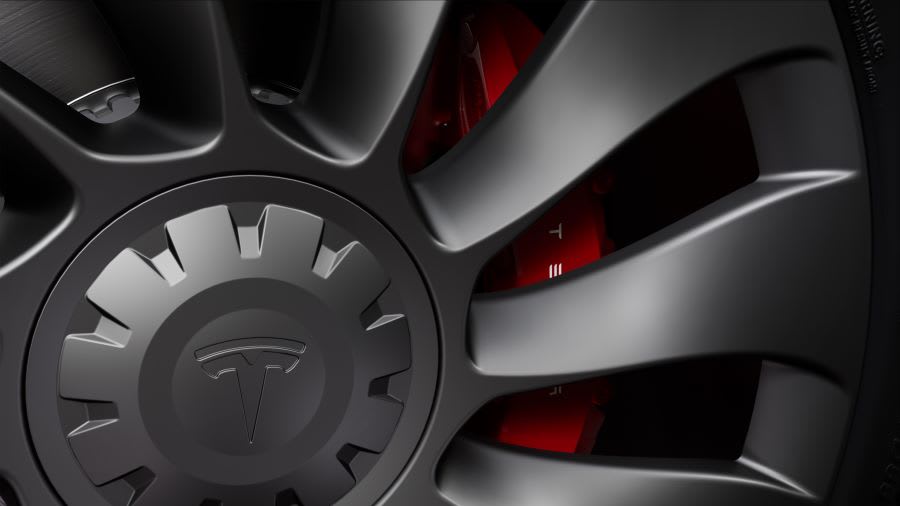
The top-of-the-range Performance variant can manage 162mph, getting from 0-60mph in just 3.1-seconds.
It adds 20-inch aluminium 'Uberturbine' alloys, performance brakes, a carbon fibre spoiler, aluminium alloy pedals and a track mode for those who want to test its limits.
Surprisingly, Tesla doesn't like to talk about power outputs, but you'll get 283PS, 449PS and 480PS, respectively, across the three variants in the range.
Range & Batteries
The entry-level RWD version claims it’ll do 305 miles before it runs out of juice.
That compares with 374 miles in the Long-Range all-wheel drive version and 340 miles in the Performance variant.
Nevertheless, while some manufacturers are cracking the 300-mile mark, most still sit in the 200s at best. So, Tesla can retain a smug smile for managing to get the entire range over the 300 barrier.
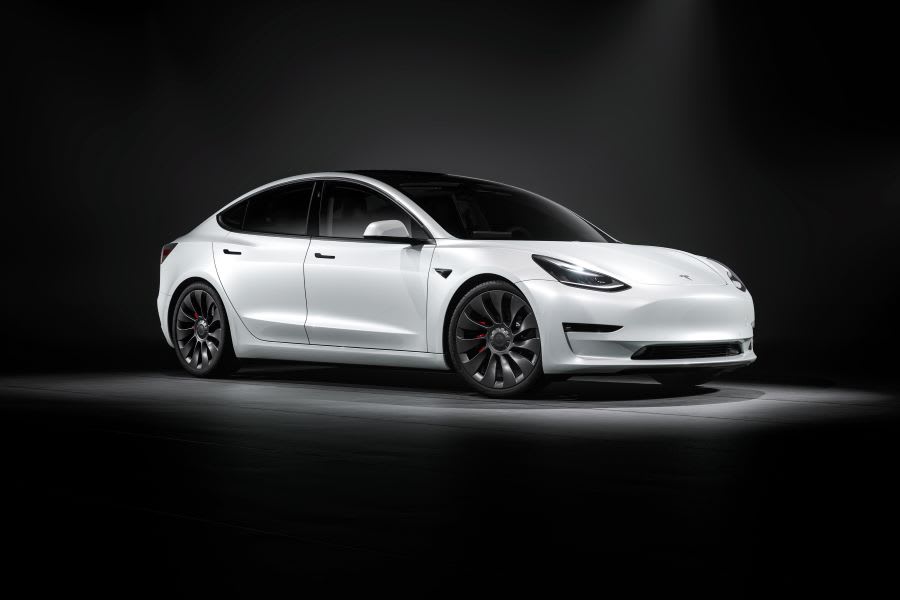
Despite this, claimed range figures are rarely reflected in practice, so you’ll likely be in the 200s in any case.
Like power outputs, Tesla doesn’t like to mention the battery capacities. But you’ll get 57.5kWh with the RWD version and 75kWh batteries in the other two variants.
Performance & Drive
Given the 5.9-second 0-60mph time of the standard RWD model and the impressive range, it’s difficult to see why you’d need anything but this unless you want serious performance.
Moving away from a standing start isn't exactly a problem, and if you're on a motorway at speed, you'll find plenty of power in reserve to pull off that quick overtake.

On average roads, when you're doing 30 to 50mph, the RWD version doesn't feel especially settled, particularly when going over lumps and bumps. Meanwhile, the Long-Range version feels a little more refined in terms of ride comfort with its 18-inch alloys.
If you go for the Performance Version, the jump up to 20-inches, plus the addition of sports suspension, makes the car feel less bouncy, as if it’s got more resistance in the springs.
This creates a firmness which means the absorption level isn't as well refined as its German rivals.
If ride comfort is a priority, you may want to consider alternatives. But it's more something to be aware of rather than something that should be putting you off.

In the bends, there's lots of grip, and although the batteries add weight, the car's low ride height and low centre of gravity mean that body roll is well controlled. This means you can throw the 3 into a corner with confidence.
The steering doesn't provide massive amounts of feedback, but it's accurate and consistent, weights up well in the bends and compliments the cornering ability nicely.
Yes, a big-engined petrol like a BMW M-car, Merc AMG or Audi S is superior. But given the extra weight that an electric car like the Model 3 carries, it's impressive.
The RWD version handles the best because the smaller battery and single electric motor mean it weighs over 200kg less than the others.
Nevertheless, you’re unlikely to be disappointed with the all-wheel drive ones either.

There is a bit of wind and road noise, especially when going quickly. But if you're considering moving to Tesla from your BMW diesel, the sheer serenity of silent driving will impress you at lower speeds.
The braking is also well-engineered, as many electric cars have brakes that feel on or off, with very little in between.
The Model 3 has consistent, smooth stopping power and offers one-pedal driving with the regenerative braking system.
Charging
Charging times depend on which version of the 3 you lease.
The RWD version charges more quickly due to the smaller battery size, although the maximum charging speed is only 170kW, meaning a 10-80% top-up takes 25 minutes.
The Long-Range and Performance variants have larger batteries but a maximum charging rate of 250kW, so a 10-80% charge only takes a couple of minutes longer.

A 0-100% charge with a 7.4kW home wall box will take just over six hours for the RWD and just over eight hours for the dual-motor variants.
Of course, one advantage of leasing a Tesla is access to its exclusive Supercharger network, allowing maximum charging speeds.
Running Costs & Emissions
Running costs are meagre given the fuel comes from the mains rather than a fuel pump, despite soaring energy bills.
That means zero emissions and huge savings on Benefit In Kind tax, making it an excellent leasing choice for company car users.

Just for information, Tesla offers a four-year warranty, limited to 50,000 miles. However, the battery and powertrain get a separate eight-year guarantee, limited to 100,000 miles with the RWD version and 120,000 miles with the Long Range and Performance models.
That should give an indication of where Tesla’s at now, as it has been criticised for poor build quality. However, improvements have been made, and it usually finds itself around mid-table in reliability surveys.
Interior & Technology
As is customary for Tesla, the Model 3's interior has a minimalist feel with few physical buttons and everything else built into the giant 15-inch infotainment screen.
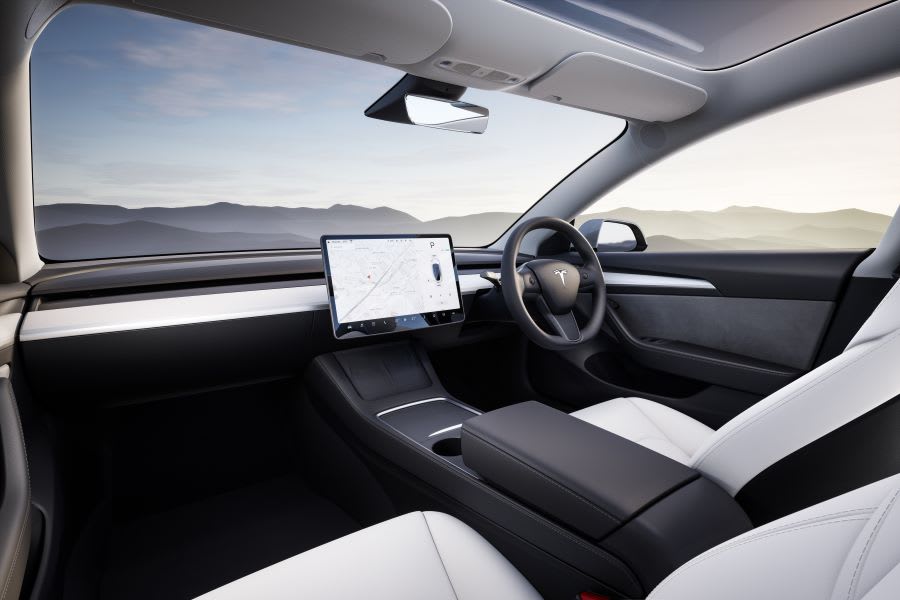
Unlike earlier Teslas, which had a portrait tablet integrated within the dashboard, nowadays, a landscape tablet sits on top of the dash.
You get switches to open the windows and a few buttons on the steering wheel, but that's about it – everything else is shoved into the touchscreen.
There are a couple of USB-C ports and two wireless charging pads beneath it.
The 3 looks nice, and the minimalist style won plenty of admirers when Tesla first launched. But other manufacturers such as BMW are doing the same in their electric cars now, while a glance at the Mercedes-Benz EQE and EQS may impress even more.

The problem with the styling is that adjusting anything means you’ve got to go through menus. Also, using the infotainment system is like doing everything through the settings page of a tablet or smartphone – not great when on the move.
Despite this, the system is well designed, clear, intuitive to use, and responsive.
And it wouldn’t be a Tesla without including some of Elon Musk’s insanity. You can play games on the infotainment system, while you can even replace the horn with an amusing sound effect if you fancy a good laugh.
Sadly, though, Tesla believes that all you need is their system. As a result, Apple CarPlay and Android Auto are not supported and remain unavailable in all Teslas.
That might be fine for now as, if your current car is more than five years old, you may not have ever used either system. But, before too long, every vehicle in the world will have Apple CarPlay and Android Auto – and people will eventually expect to be offered it.

Tesla is a company that considers itself the pioneer of mass-market electric cars. So, it understandably wants people to follow its lead. Still, we question how much longer it can realistically resist allowing the tech giants of Apple and Google to join the party.
While everything seems solid, there's just something about the Tesla's interior that doesn't quite match the quality of the German premium brands.
The interior is an improvement on the old, pre-facelifted version, though – and there are signs Tesla has been taking the criticisms on board over build quality.
Practicality & Boot Space
The driving position in the Model 3 is good, if a little bit higher than we imagined, given the car's appearance is lower to the ground.
The seats are comfortable, but they don’t hold you exceptionally well in the bends. So additional bolstering on the sides is needed, especially if you're leasing the Performance version and want to chuck it around corners at speed.
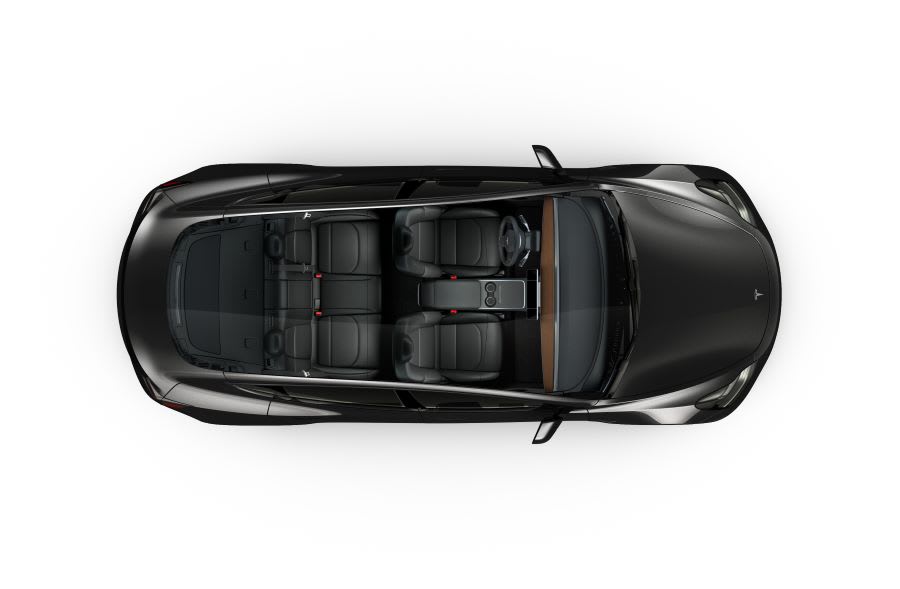
Visibility out of the front is okay, although the pillars are a bit thick.
At the rear, we were surprised at how much we could see, given the pronounced slope of the roofline and the steeply angled rear window means the pillar crosses your line of sight diagonally.
There is lots of room in the front, so even the tallest of drivers won’t be disappointed, while in the rear, there’s still plenty of space. But the aggressive slope of the roofline does limit headroom a little.
At least there's no central tunnel running down the middle, so rear-seat passengers have a flat floor, which helps when stretching feet and legs.
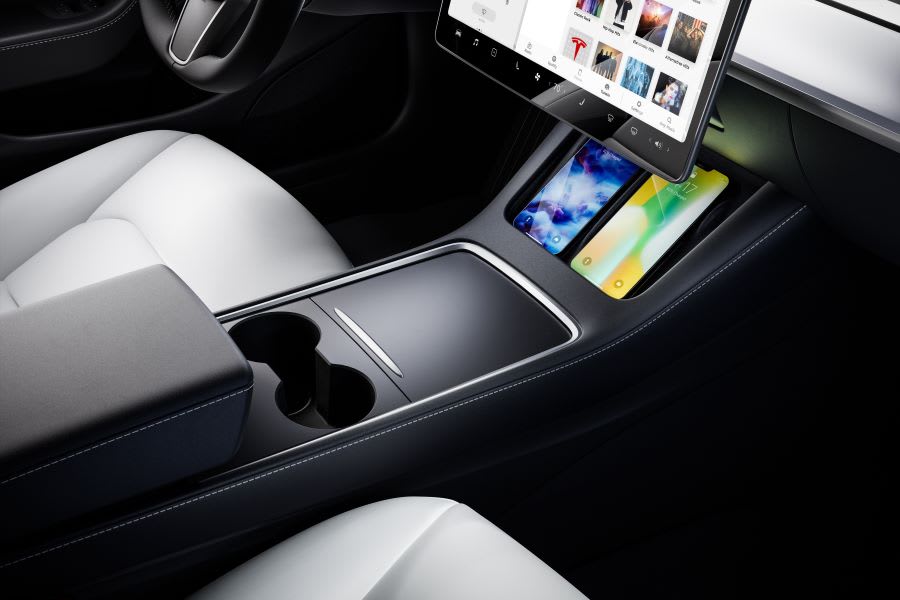
A couple of USB-C ports are included in the front, along with two wireless phone charging pads. Meanwhile, there are plenty of storage areas, including two cubbies in the centre console and reasonably sized door bins.
Another oddity of Tesla is that it quotes its boot space figures in cubic metres rather than litres. Still, it translates as 561 litres, which expands to around 850 litres with the rear seats folded down, meaning it's bigger than most of its premium rivals.
A powered boot lid is offered across the range, too, which is activated via a button on the boot, your smartphone app or the touchscreen.
The rear seats only have a 60/40 split, which is less versatile than the 40/20/40 offered in the BMW 3-Series.
As a bonus, there’s an additional 88 litres of storage space in the frunk (in the boot – the ‘front trunk’, based on American English – if you didn’t get it).
Safety
Tesla’s Model 3 scored very highly when crash-tested by Euro NCAP, comfortably earning a top five-star rating.
It notched up 96% for adult occupants, 86% for children and 94% for safety assists, helped by the plethora of clever tech it comes with as standard.
You get blind-spot monitoring, automatic emergency braking, adaptive cruise control, forward collision warning, and lane departure avoidance.

Of course, the actual gadgetry everyone wants is found in the optional extras, which we'll come on to.
Every Tesla collects data which is sent back to the head office and used to improve the collision avoidance software, which is then updated over the air.
So, Tesla says, your car should get safer and safer over time.
Options
Very few options are offered with the Model 3, but that's partly because the entry-level RWD version is very well-equipped.
You have to fork out more if you want any body colour other than white, while the RWD and Long-Range versions can be upgraded to 19-inch alloys if you prefer.
Enhanced Autopilot incorporates the SatNav into the automatic steering and braking, as well as providing automatic parking and the ability to summon the vehicle remotely.

The full-fat Self-Driving Capability can be bought instead, which adds all of the above plus the ability to stop at give way signs and traffic lights.
Both are expensive, with Self-Driving Capability costing twice as much as Enhanced Autopilot.
But, of course, self-driving is the party piece that everyone wants in a Tesla.
Just beware that it costs extra.
Rival Cars
As we said earlier, in terms of its DNA, the Polestar 2 is the closest rival to the Tesla Model 3 on paper.
It is a very impressive car which, in some ways, meets or exceeds Tesla’s standards.

Of course, in practice, Tesla is hoping to convince you to ditch your BMW 3-Series, Merc C-Class or Audi A4 for one.
The Model 3 isn’t as refined as any of the German brands, but these premium cars aren’t available as all-electric.
If you want to lease an all-electric vehicle but aren’t necessarily fussed about what sort of car it is, the Audi Q4 e-tron is a viable alternative, as is the BMW i4.
Don’t be put off by names like Kia, Skoda and Hyundai, who also offer their worthy contenders.
There’s even the newly-launched MG 4, which is surprisingly impressive and much cheaper.
Verdict & Next Steps
Overall, the Tesla Model 3 is desirable, reasonably practical, has an excellent range between charges, is great at accelerating, and is pretty good at going around bends.
It is generously equipped at entry-level, while the Performance version offers a 0-60mph figure that many supercars can’t match.
But we’d suggest sticking with the RWD version.

Unless you need the Long-Range or want the extra pace of the Performance, the RWD offers everything you need.
The Model 3 isn’t cheap to lease, but when you look at the price of all-electric cars – the Model S included – it starts to look like good value for money.
Its Self-Driving Capability is unmatched, too, if that’s your sort of thing, although that pushes the price up drastically.
The Model 3 is impressive, but we wouldn’t lease one for the sake of it.
Five years ago, you needed a Tesla to enjoy a good electric car, but nowadays, there are plenty of excellent alternatives out there.
While most can’t match the Tesla for tech, quirkiness and ferocious acceleration, some can beat it in the areas that matter to most.
Where to Next?
View our latest Tesla Model 3 Leasing Deals - from £607.28 per month inc VAT**
Looking for a great leasing deal? Check out our incredible range of car lease deals
New luxury electric saloon? Read our latest Car Reviews and find the right model for you
Want to know more about leasing? Take a look at our comprehensive Leasing Guides
Interested in everything motoring? Why not catch up on all the latest Car Leasing News.
*Score based on Select’s unique meta score analysis, taking into account the UK’s top five leading independent car website reviews of the Tesla Model 3
**Correct as of 07/11/2022. Based on 9 months initial payment, 5,000 miles over a 48 month lease. Initial payment equivalent to 9 monthly payments or £5,465.52. Ts and Cs apply. Credit is subject to status.





















